The OUVISLITE mini PC is just one of the many mini pc’s seemingly making their way into the homes of consumers these days. This growing trend should not surprise anyone. Mini PCs offer a myriad of conveniences and advantages least of which is their space saving form factor, low power consumption and in many cases, affordability.
We have spent the last several weeks evaluating this OUVISLITE mini pc trying to better understand who may benefit the most from owning this device. Here is what we found.
On the outside
The OUVISLITE mini PC shares many of the external characteristics of other mini PCs. To begin with, it has a square palm-sized form factor that is found among many of its peers.
Looking over the external features of the device we begin with the front side which is bare other than a single LED strip which lights up blue when the PC is turned on. One one of the sides, you will find two USB 3.0 ports and a USB 2.0 port along with a button to turn the pc on and off. On the opposite side, there is a VGA port for those that may need it. The rear is where we find most of the peripheral ports beginning with a Kensington lock, audio port, Gigabit ethernet port, two HDMI ports and of course, a power port.
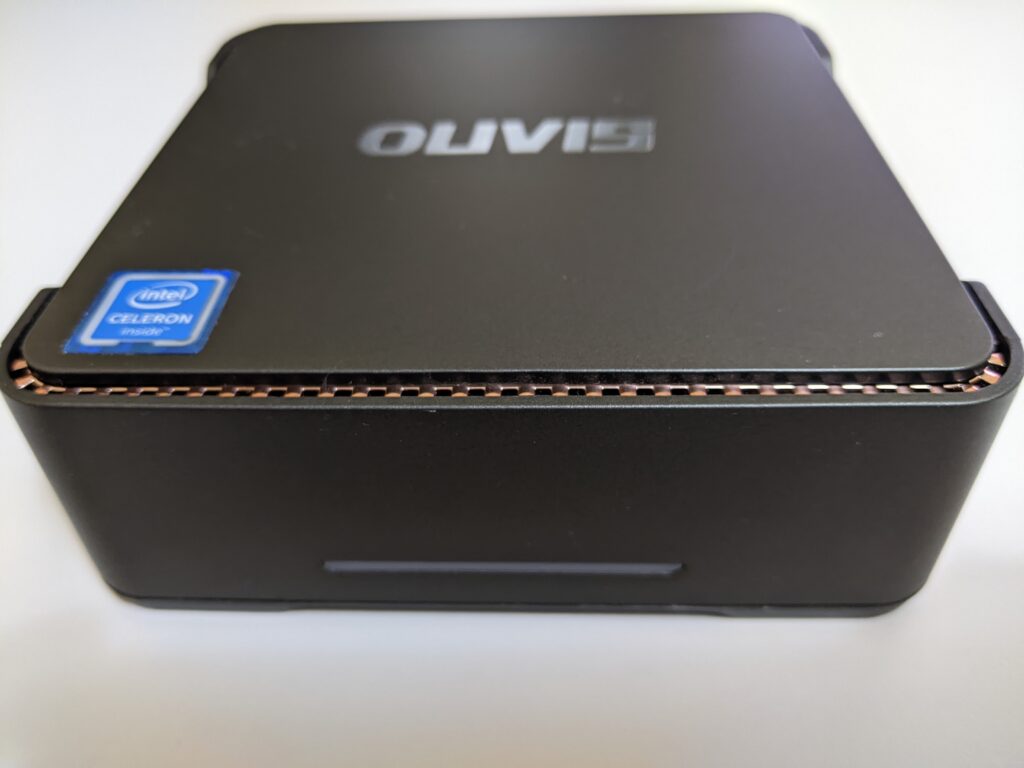
The top of the PC can be removed revealing a storage bay for a 2.5″ SATA SSD of up to 2GBs. The lid itself, is unremarkable with the exception of some branding by OUVISLITE. Like many mini PCs that we have come across, there is a vent immediately under the lid which wraps around the entire mini PC creating the capacity for heat escape either passively when the fan is not running or actively, when it is.
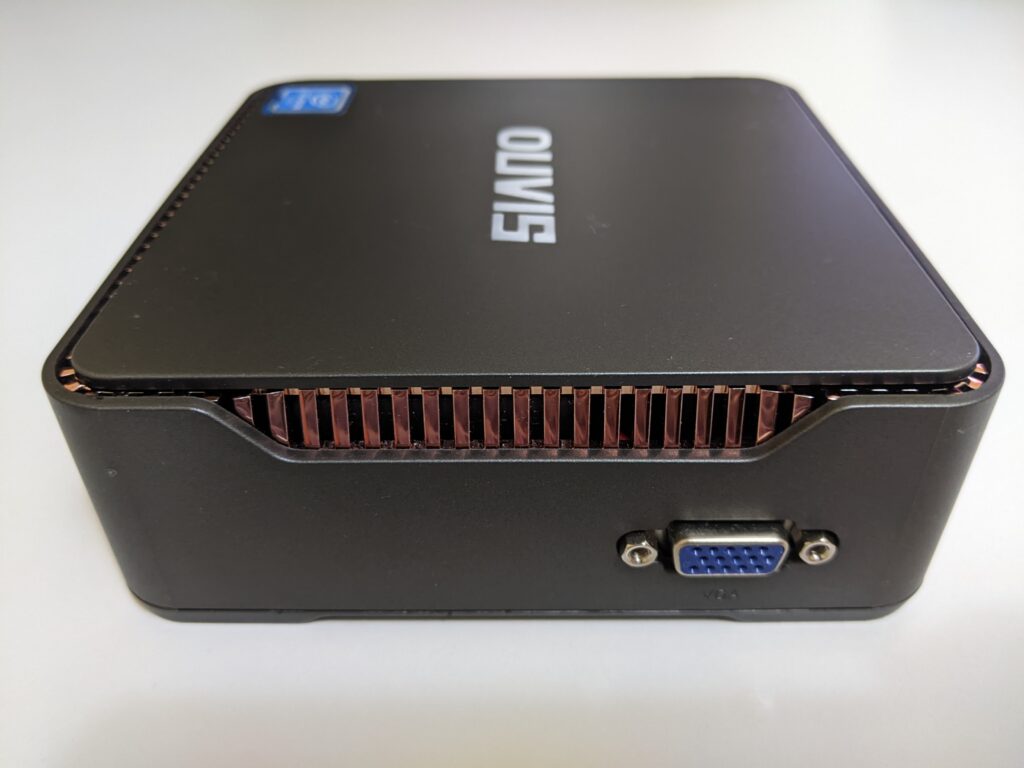
On the inside
This mini PC is powered by Intel’s Gemini Lake Celeron J4125. The CPU features 4 cores and 4 threads with a basic clock speed of 2.00 GHz and a burst frequency that can reach 2.70 GHz.

The TDP of the CPU is a very efficient 10 Watts making this a perfect chip for mobile devices and small form factored PCs such as the OUVISLITE mini pc.
It will come as no surprise to learn that the device utilizes Intel integrated graphics. The PC’s graphics use Intel’s modest UHD Graphics 600 which features a paltry 12 execution units vs the 24 execution units found in the Kamrui AK1 Pro Mini PC which we reviewed. For more information on the Intel’s Celeron J4125, please see Intel’s specification sheet found here.
Although the CPU is capable of being passively cooled, OUVISLITE has installed a blower style fan inside that does an excellent job at keeping the internal components cool.
The fan, which is active more than it is inactive, is loud enough to be easily heard whether you have the PC on a desk infront of you or mounted on the back of a monitor. Just how loud is the fan? Well, from a distance of 12 inches away and using an anemometer, our measurements yielded an average decibel level of just over 50 when the fan is spinning. This is considerably louder than that of the Kamrui AK1 Pro Mini PC. That review can be found here.
The hard drive that OUVISLITE has elected to use inside this mini PC is a Netac M.2 2242 SATA drive with 128GB. Out of the box, that leaves just about 120GB of actual usable space. We find this level of storage to be unacceptable for any PC in 2022 and would like to see OUVISLITE offer at least 256GB going forward, especially as software becomes more and more storage hungry. The saving grace is that the SSD can be swapped out with one of your own choosing.
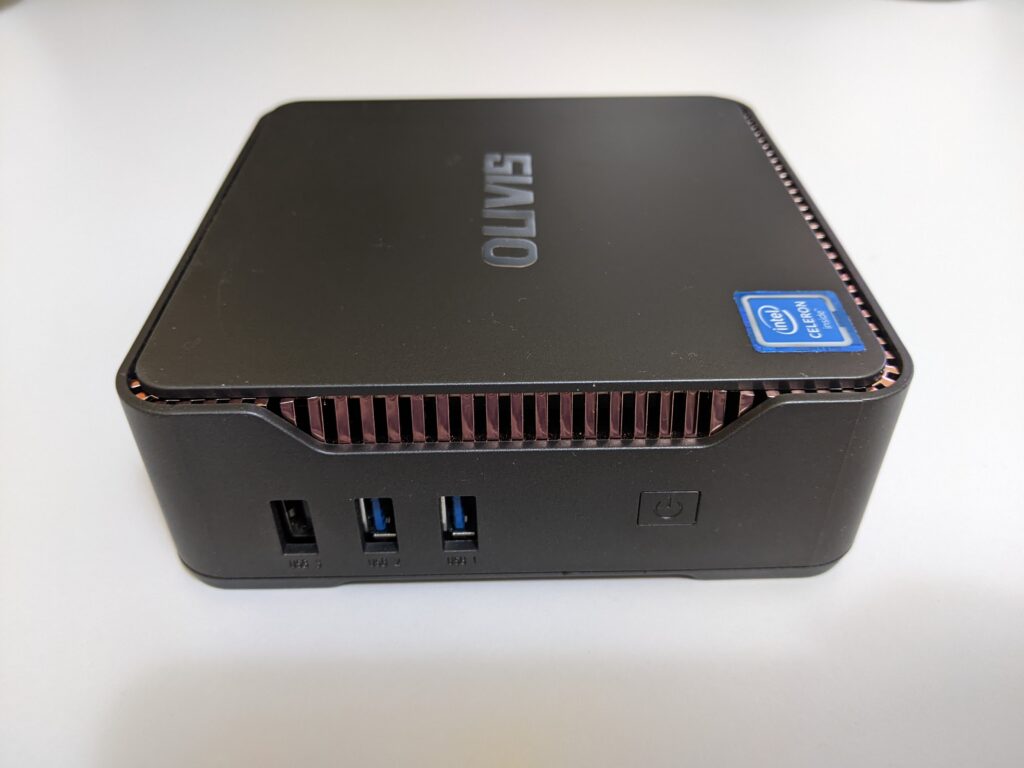
The Netac SSD is a budget hard drive but one that has a relatively good reputation as a solid performer. Using Crystal Disk Mark 8, the SSD was able to achieve read speeds of 507MB/s while write speeds were measured at 411 MB/s. These results also fall short of the ‘read’ and ‘write’ speeds measured for the Kamrui AK1 Pro Mini PC. That device utilizes a FuturePath M.2 SATA drive which had ‘read’ speeds of 555 MB/s and ‘write’ speeds of 476 MB/s.
CPU performance
We took our OUVISLITE mini pc and benchmarked its CPU using Geekbench 5.3. This would give us an apples to apples comparison with the Kamrui AK1 Pro Mini PC which we also evaluated using the same software.
As expected, here too the Celeron J4125 CPU could not compete with the Kamrui’s Intel Celeron N5105. The single core score for the OUVISLITE mini pc was just 433 while the multi-core score was 1293. Comparing those values with the Kamrui’s Celeron N5105, we see significant outperformance by the Kamrui AK1, which scored 624 for single core and 2042 for multi-core tests.
Furthermore, the score in the Geekbench OpenCL/Compute test, which evaluates performance of the integrated graphics, found that the OUVISLITE scored well below the Kamrui obtaining a final value of just 1660 while the Kamrui came in at 3655.
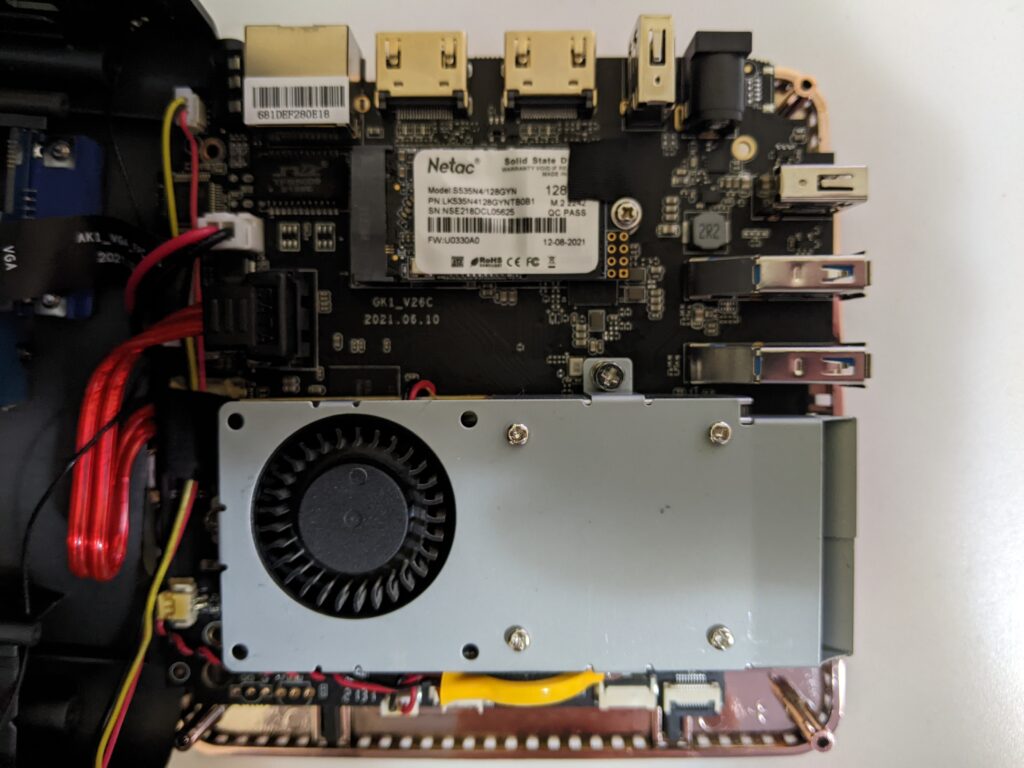
Dual channel configuration
Continuing with our analysis of the OUVISLITE mini PC, we were pleasantly surprised to find that the RAM memory is configured in a dual channel operating mode. Despite some lapses in other areas, OUVISLITE maximizes the memory of the PC by splitting the RAM components into two sticks of 4GB each. Incidentally the RAM soldered on to the motherboard making swapping impossible.
Streaming, Office and surfing
The technical benchmarks discussed up until now are important however, they can represent something abstract for a potential user or purchaser of a mini pc. Therefore, to balance our technical analysis using third party software, we also looked at how this PC performs with typical day to day real world activities such as streaming browsing and within business applications such as Microsoft 365.
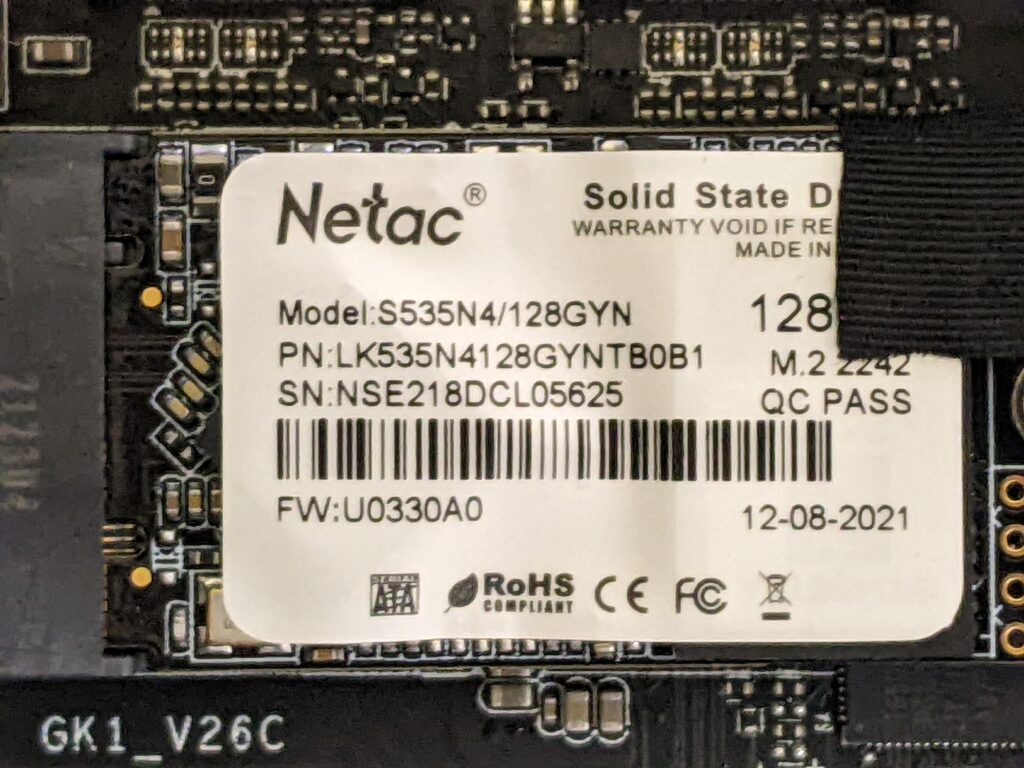
Many purchasers of mini PCs often like to use these palm-sized computers for streaming, since they can be mounted on the back of a monitor or tv and generally do a very good job at streaming high quality material. For our streaming tests we evaluated the PC’s ability to stream using YouTube videos at various outputs.
First, we looked at the performance of the OUVISLITE mini PC while streaming 4K videos at 60Hz. The results were subpar and well below that of the Kamrui AK1. The OUVISLITE dropped a whopping 1220 frames for every 4000 streamed at the 4K/60Hz output. The Kamrui AK1 Pro on the other hand only dropped 20 frames for every 4000 streamed when we reviewed that device – a significant difference.
Next we evaluated the OUVISLITE with respect to 4K and 30Hz to see if there would be an improvement and there was. On average the mini pc dropped an average of 173 frames per 4000 streamed which is a vast improvement over the 4K video at 60Hz output but still not enough for us to consider the performance to be satisfactory. Even at resolutions of 1080p, we found that the OUVISLITE mini PC struggled.
As a result, we would not recommend this mini PC if you wish to use it for any kind of streaming activity.
Office applications worked better. We opened several applications simultaneously including several templates in Microsoft Word, Excel, Power Point, Outlook as well as a few other business oriented applications such as Adobe Reader, and the CPU was able to handle this without any hiccups or stuttering.
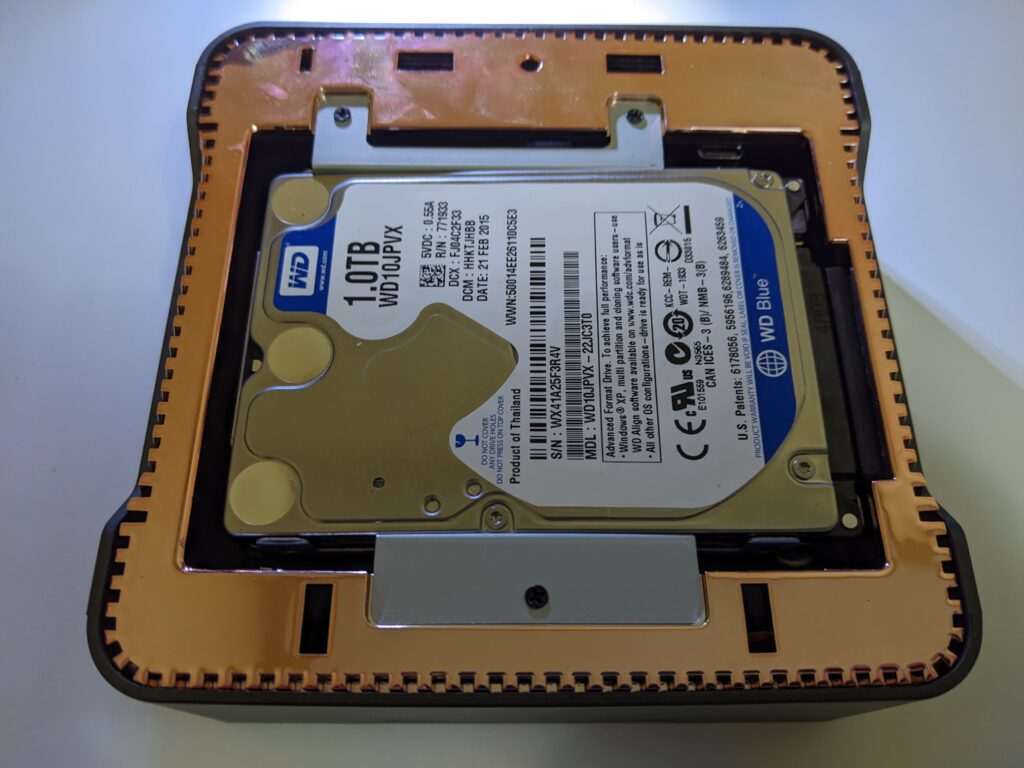
Lastly, we looked at how the OUVISLITE mini PC would handle several simultaneously open web pages to investigate whether or not device could manage such a workload without any problems. Our list included sites such as Facebook, Youtube, ABC, CBS, NBC, CTV, Pinterest, and Instagram and others where image rendering would play a significant role. We noticed the ability to render images slowed down as we reached 11 web pages.
As a result, we would conclude that when it comes to multitasking on the internet, the OUVISLITE mini PC performs on par with other Intel Celeron chips in its class.
Thermals
Thanks to the active cooling blower style fan in the OUVISLITE mini PC, core temperatures are generally very good. Even under load CPU temperatures remain in the 75-80 degrees Celsius range which is well below any throttling temperatures associated with the Intel Celeron J4125.
Hard drive temperatures are also kept in check with temperatures in the 40-45 degrees Celsius range.
Although these thermals are very welcome, they do not come without a cost and that cost is noise. We tested this mini PC with a 1440p monitor and just the sheer number of pixels contained in such a monitor, had the blower fan working virtually non-stop. The fan’s speed cannot be adjusted and so it will be either running at maximum power or not running at all. Any added activity that puts the system under any stress will result in a the fan working the entire time you are using the mini PC and as we mentioned earlier, this may become a nuisance. Our best assessment is that this mini pc is best used with a monitor that contains a resolution of no more than 1080p.
Gaming
Given the constraints associated with the integrated graphics of the Celeron J4125, one reason you should not be purchasing this mini PC is for gaming. The Celeron J4125 is at best, capable of playing simple games and perhaps emulated games as well. For example, we were able to use the system to play Minecraft and some old classic emulated games but beyond that we founder new games to simply be unplayable. For gaming, you are better off looking for a PC with a dedicated graphics card.
Specifications
CPU: Intel Celeron J4125
Cores: 4
Threads: 4
Base Processor Frequency: 2.00GHz
Burst Frequency: 2.70GHz
Graphics: Intel UHD Graphics 600
4K support: Yes, at 60Hz** (This requires a connection with a Display Port which this mini does not have)
4K support with HDMI: Yes, at 30 Hz
Windows License: Yes, Windows 11 Pro
RAM: 8 GB
Memory: 128 GB M.2 SATA SSD (2242)
Additional Storage: Yes, extra 2.5″ SSD bay
Dual Band Wifi 802.11a/b/g/n/ac and Bluetooth 4.2 connectivity
2x HDMI ports
2x USB 2.0 ports
2x USB 3.0 ports
1x Gigabit Ethernet port
1x Headphone and Mic port
VESA Mount Included: Yes
Semi-restricted BIOS
Performance metrics
Geekbench 5.3 Single Core: 433
Geekbench 5.3 Multi Core: 1293
Cinebench r23 Single Core: 391
Cinebench r23 Multi Core: 1221
Geekbench 5.3 OpenCL/Compute: 1660
CrystalDiskMark 8.0.4: read – 507MB/s, write – 419MB/s
Youtube 4K @ 60fps: 1220 dropped frames per 4000 frames
Youtube 4K @ 30fps: 173 dropped frames per 4000 frames
What we like
Compact size: Just like the Kamrui AK1 Pro Mini PC, the OUVISLITE mini PC has a small form factor measuring just over 5 inches x 5 inches, making it a perfect companion for a cluttered desk and a space saver. You can also attach the mini PC to the back of a monitor using the provided VESA bracket.
Budget friendly: Although we have found instances of mini PCs using superior chips being sold for less than the OUVISLITE mini PC, this PC is still budget friendly both in terms of initial cost outlay as well as operating costs. Our suggestion however does not change. You can find better performing mini PCs for less with similar operating costs.
Portability: What we really like about mini PCs is the ability to transport a full desktop computer with you. If you couple the OUVISLITE with a portable monitor and foldable keyboard, you have yourself a full system that can easily travel with you – yes, we have done this.
Extra storage: The ability to add an additional 2.5 inch SSD into the hard drive bay can increase storage capacity significantly.
Dual channel memory: We really like that the 8GB RAM memory is split into two channels rather than one which aids in performance.
What we don’t like
No USB-C port: There is no USB-C port on this PC and as a result the ability to add peripherals which are increasingly using USB-C cables.
Difficult to upgrade: Although we are pleased with the dual channel configuration of the RAM, we are disappointed that the RAM is soldered on to the motherboard preventing a user from upgrading or swapping out the in-place configuration.
Loud fan: While the fan does an excellent job at keeping the system’s critical components cool, the more than 50 decibel measurement means that this fan can become a distraction not only for the person using the mini PC but for those in the immediate vicinity.
Poor graphical performance: The Intel Celeron J4125 just does not cut it for anything other than simple daily tasks. We encountered poor playback of videos and the inability to play even some of the simplest games due to the poor performance of the integrated graphics. The Cinebench r23 scores reinforced these findings as well.
Final thoughts
We began this review by asking the question of who this mini PC may be best suited for. In our opinion, the OUVISLITE mini PC powered by Intel’s Celeron J4125 is an average mini PC at best. The CPU is simply not made for heavy workloads, streaming or playing video games. Instead this PC should remain focused on those consumers looking to surf the internet, use social media and use general office applications. If you need a system to do more, we would suggest looking elsewhere.
While the system is capable of multi-tasking, some tasks work better than others. Anything involving use of the graphics is limited at best, however the CPU is reasonably able to accomplish many of the day to day tasks that one might encounter at home. Checking email and interacting with friends on social media is easily handled. Surfing the internet and writing reports and creating presentations are also items that the Celeron J4125 has no problems with, however, once you begin to incorporate several activities at once, you will see the limitations come to the fore. Additionally, once the fan is activated, we found that it would remain spinning for extended periods of time – far more than we liked.
Finally and most inexplicably, is that despite the significant superior performance of Kamrui AK1 Pro Mini PC vs the OUVISLITE mini PC, we have often come across mini PCs using the Intel Celeron J4125 being more expensive than PCs that feature the Intel Celeron N5105. As our testing has shown, the N5105 is the superior CPU so we would recommend passing on the OUVISLISTE mini PC and looking for an alternative which utilizes the Intel Celeron N5095 or Intel Celeron N5105 because you will almost certainly find mini PCs featuring the latter two CPUs at a better price than a PC that features the Celeron J4125 such as the OUVISLITE mini PC.
For the latest price and further information on the Kamrui AK1 Pro Mini PC please click on the buttons below